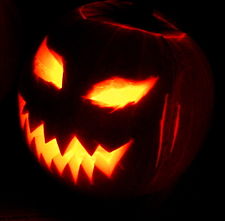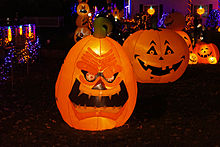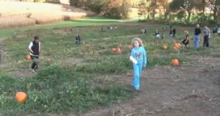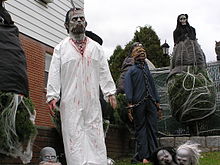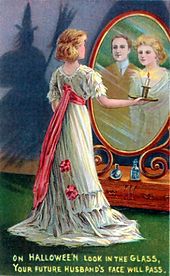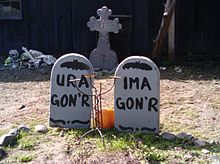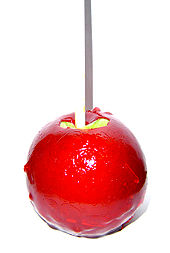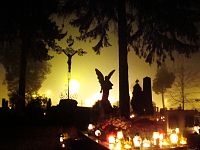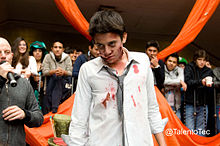
Halloween
Background Information
SOS Children produced this website for schools as well as this video website about Africa. SOS Children works in 45 African countries; can you help a child in Africa?
Halloween or Hallowe'en (a contraction of "All Hallows' Evening"), also known as All Hallows' Eve, is a yearly celebration observed in a number of countries on October 31, the eve of the Western Christian feast of All Hallows (or All Saints) and the day initiating the triduum of Hallowmas.
According to many scholars, All Hallows' Eve is a Christianised feast originally influenced by western European harvest festivals, and festivals of the dead with possible pagan roots, particularly the Celtic Samhain. Other scholars maintain that it originated independently of Samhain and has solely Christian roots.
Typical festive Halloween activities include trick-or-treating (also known as " guising"), attending costume parties, carving pumpkins into jack-o'-lanterns, lighting bonfires, apple bobbing, visiting haunted attractions, playing pranks, telling scary stories, and watching horror films.
Etymology
The word Halloween was first used in the 16th century and represents a Scottish variant of the fuller All Hallows' Eve ('evening'), that is, the night before All Hallows' Day. Although the phrase All Hallows' is found in Old English (ealra hālgena mæssedæg, mass-day of all saints), All Hallows' Eve is itself not seen until 1556.
History
Celtic influences
Though the origin of the word Halloween is Christian, the holiday is commonly thought to have pagan roots. Historian Nicholas Rogers, exploring the origins of Halloween, notes that while "some folklorists have detected its origins in the Roman feast of Pomona, the goddess of fruits and seeds, or in the festival of the dead called Parentalia, it is more typically linked to the Celtic festival of Samhain", which comes from the Old Irish for "summer's end". Samhain (pronounced SAH-win or SOW-in) was the first and most important of the four quarter days in the medieval Gaelic ( Irish, Scottish and Manx) calendar. It was held on or about October 31 – November 1 and kindred festivals were held at the same time of year in other Celtic lands; for example the Brythonic Calan Gaeaf (in Wales), Kalan Gwav (in Cornwall) and Kalan Goañv (in Brittany). Samhain is mentioned in some of the earliest Irish literature and many important events in Irish mythology happen or begin on Samhain. It marked the end of the harvest season and the beginning of winter or the 'darker half' of the year. This was a time for stock-taking and preparing for the cold winter ahead; cattle were brought back down from the summer pastures and livestock were slaughtered. In much of the Gaelic world, bonfires were lit and there were rituals involving them. Some of these rituals hint that they may once have involved human sacrifice. Divination games or rituals were also done at Samhain.
Samhain (like Beltane) was seen as a time when the 'door' to the Otherworld opened enough for the souls of the dead, and other beings such as fairies, to come into our world. The souls of the dead were said to revisit their homes on Samhain. Feasts were had, at which the souls of dead kin were beckoned to attend and a place set at the table for them. Lewis Spence described it as a "feast of the dead" and "festival of the fairies". However, harmful spirits and fairies were also thought to be active at Samhain. People took steps to allay or ward-off these harmful spirits/fairies, which is thought to have influenced today's Halloween customs. Before the 20th century, wearing costumes at Samhain was done in parts of Ireland, Mann, the Scottish Highlands and islands, and Wales. Wearing costumes may have originated as a means of disguising oneself from these harmful spirits/fairies, although some suggest that the custom comes from a Christian or Christianized belief (see below). In Ireland, people went about before nightfall collecting for Samhain feasts and sometimes wore costumes while doing so. In the 19th century on Ireland's southern coast, a man dressed as a white mare would lead youths door-to-door collecting food; by giving them food, the household could expect good fortune from the 'Muck Olla'. In Moray during the 18th century, boys called at each house in their village asking for fuel for the Samhain bonfire. The modern custom of trick-or-treating may have come from these practices. Alternatively, it may come from the Christian custom of souling (see below).
Making jack-o'-lanterns at Halloween may also have sprung from Samhain and Celtic beliefs. Turnip lanterns, sometimes with faces carved into them, were made on Samhain in the 19th century in parts of Ireland and the Scottish Highlands. As well as being used to light one's way while outside on Samhain night, they may also have been used to represent the spirits/fairies and/or to protect oneself and one's home from them. Another legend is that a trickster named Jack decided one day to trick the Devil. He trapped the Devil in a pumpkin and paraded him around town. Eventually, Jack let the Devil out and the Devil put a curse on Jack and forever made him a spirit in hell. On Halloween, Jack is released to terrorize the country all night. To protect themselves, the Irish would place a pumpkin with a face outside to scare Jack into believing it was the Devil. However, a Christian origin has also been proposed.
Christian influences
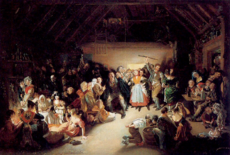
Halloween is also thought to have been influenced by the Christian holy days of All Saints' Day (also known as All Hallows, Hallowmas or Hallowtide) on November 1 and All Souls' Day on November 2. They are a time for honoring the saints and praying for the recently departed who had yet to reach Heaven. All Saints was introduced in the year 609, but was originally celebrated on May 13. In 835, it was switched to November 1 (the same date as Samhain) at the behest of Pope Gregory IV. Some have suggested this was due to Celtic influence, while others suggest it was a Germanic idea.
By the end of the 12th century they had become holy days of obligation across Europe and involved such traditions as ringing bells for the souls in purgatory. "Souling", the custom of baking and sharing soul cakes for "all crysten christened souls", has been suggested as the origin of trick-or-treating. Groups of poor people, often children, would go door-to-door on All Saints/All Souls collecting soul cakes, originally as a means of praying for souls in purgatory. Similar practices for the souls of the dead were found as far south as Italy. Shakespeare mentions the practice in his comedy The Two Gentlemen of Verona (1593), when Speed accuses his master of "puling [whimpering or whining] like a beggar at Hallowmas." The custom of wearing costumes has been linked to All Saints/All Souls by Prince Sorie Conteh, who wrote: "It was traditionally believed that the souls of the departed wandered the earth until All Saints' Day, and All Hallows' Eve provided one last chance for the dead to gain vengeance on their enemies before moving to the next world. In order to avoid being recognised by any soul that might be seeking such vengeance, people would don masks or costumes to disguise their identities". In Halloween: From Pagan Ritual to Party Night, Nicholas Rogers explained Halloween jack-o'-lanterns as originally being representations of souls in purgatory. In Brittany children would set candles in skulls in graveyards.
In Britain, these customs came under attack during the Reformation as Protestants berated purgatory as a " popish" doctrine incompatible with the notion of predestination. The rising popularity of Guy Fawkes Night (5 November) from 1605 onward, saw many Halloween traditions appropriated by that holiday instead, and Halloween's popularity waned in Britain, with the noteworthy exception of Scotland. There and in Ireland, the rebellious Guy Fawkes was not viewed with the same criminality as in England, and they had been celebrating Samhain and Halloween since at least the early Middle Ages, and the Scottish kirk took a more pragmatic approach to Halloween, seeing it as important to the life cycle and rites of passage of communities and thus ensuring its survival in the country.
Spread to North America
North American almanacs of the late 18th and early 19th century give no indication that Halloween was celebrated there. The Puritans of New England, for example, maintained strong opposition to Halloween and it was not until the mass Irish and Scottish immigration during the 19th century that it was brought to North America in earnest. Confined to the immigrant communities during the mid-19th century, it was gradually assimilated into mainstream society and by the first decade of the 20th century it was being celebrated coast to coast by people of all social, racial and religious backgrounds.
Symbols
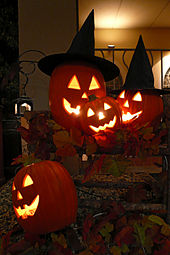
Development of artifacts and symbols associated with Halloween formed over time. The turnip has traditionally been used in Ireland and Scotland at Halloween, but immigrants to North America used the native pumpkin, which is both much softer and much larger – making it easier to carve than a turnip. Subsequently, the mass marketing of various size pumpkins in autumn, in both the corporate and local markets, has made pumpkins universally available for this purpose. The American tradition of carving pumpkins is recorded in 1837 and was originally associated with harvest time in general, not becoming specifically associated with Halloween until the mid-to-late 19th century.
The modern imagery of Halloween comes from many sources, including national customs, works of Gothic and horror literature (such as the novels Frankenstein and Dracula) and classic horror films (such as Frankenstein and The Mummy). One of the earliest works on the subject of Halloween is from Scottish poet John Mayne, who, in 1780, made note of pranks at Halloween; "What fearfu' pranks ensue!", as well as the supernatural associated with the night, "Bogies" (ghosts), influencing Robert Burns' Halloween 1785. Elements of the autumn season, such as pumpkins, corn husks and scarecrows, are also prevalent. Homes are often decorated with these types of symbols around Halloween.
Halloween imagery includes themes of death, evil, the occult, and mythical monsters. Black, orange, and sometimes purple are Halloween's traditional colors.
Trick-or-treating and guising
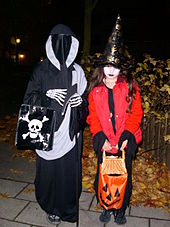
Trick-or-treating is a customary celebration for children on Halloween. Children go in costume from house to house, asking for treats such as candy or sometimes money, with the question, "Trick or treat?" The word "trick" refers to "threat" to perform mischief on the homeowners or their property if no treat is given.
In Scotland and Ireland, guising – children disguised in costume going from door to door for food or coins – is a traditional Halloween custom, and is recorded in Scotland at Halloween in 1895 where masqueraders in disguise carrying lanterns made out of scooped out turnips, visit homes to be rewarded with cakes, fruit and money. The practice of Guising at Halloween in North America is first recorded in 1911, where a newspaper in Kingston, Ontario reported children going "guising" around the neighbourhood.
American historian and author Ruth Edna Kelley of Massachusetts wrote the first book length history of Halloween in the US; The Book of Hallowe'en (1919), and references souling in the chapter "Hallowe'en in America":
The taste in Hallowe'en festivities now is to study old traditions, and hold a Scotch party, using Burn's poem Hallowe'en as a guide; or to go a-souling as the English used. In short, no custom that was once honored at Hallowe'en is out of fashion now.
In her book, Kelley touches on customs that arrived from across the Atlantic; "Americans have fostered them, and are making this an occasion something like what it must have been in its best days overseas. All Halloween customs in the United States are borrowed directly or adapted from those of other countries". While the first reference to "guising" in North America occurs in 1911, another reference to ritual begging on Halloween appears, place unknown, in 1915, with a third reference in Chicago in 1920.
The earliest known use in print of the term "trick or treat" appears in 1927, from Blackie, Alberta, Canada:
Hallowe'en provided an opportunity for real strenuous fun. No real damage was done except to the temper of some who had to hunt for wagon wheels, gates, wagons, barrels, etc., much of which decorated the front street. The youthful tormentors were at back door and front demanding edible plunder by the word “trick or treat” to which the inmates gladly responded and sent the robbers away rejoicing.
The thousands of Halloween postcards produced between the turn of the 20th century and the 1920s commonly show children but not trick-or-treating. The editor of a collection of over 3,000 vintage Halloween postcards writes, "There are cards which mention the custom [of trick-or-treating] or show children in costumes at the doors, but as far as we can tell they were printed later than the 1920s and more than likely even the 1930s. Tricksters of various sorts are shown on the early postcards, but not the means of appeasing them". Trick-or-treating does not seem to have become a widespread practice until the 1930s, with the first U.S. appearances of the term in 1934, and the first use in a national publication occurring in 1939.
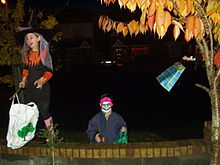
Costumes
Halloween costumes are traditionally modeled after supernatural figures such as monsters, ghosts, skeletons, witches, and devils. Over time, in the United States the costume selection extended to include popular characters from fiction, celebrities, and generic archetypes such as ninjas and princesses.
Dressing up in costumes and going "guising" was prevalent in Ireland and Scotland at Halloween by the late 19th century. Costuming became popular for Halloween parties in the US in the early 20th century, as often for adults as for children. The first mass-produced Halloween costumes appeared in stores in the 1930s when trick-or-treating was becoming popular in the United States.
Halloween costume parties generally fall on or around October 31, often on the Friday or Saturday before Halloween.
UNICEF
"Trick-or-Treat for UNICEF" is a fundraising program to support UNICEF, a United Nations Programme that provides humanitarian aid to children in developing countries. Started as a local event in a Northeast Philadelphia neighbourhood in 1950 and expanded nationally in 1952, the program involves the distribution of small boxes by schools (or in modern times, corporate sponsors like Hallmark, at their licensed stores) to trick-or-treaters, in which they can solicit small-change donations from the houses they visit. It is estimated that children have collected more than $118 million for UNICEF since its inception. In Canada, in 2006, UNICEF decided to discontinue their Halloween collection boxes, citing safety and administrative concerns; after consultation with schools, they instead redesigned the program.
Games and other activities
There are several games traditionally associated with Halloween parties. One common game is dunking or apple bobbing, which may be called "dooking" in Scotland in which apples float in a tub or a large basin of water and the participants must use their teeth to remove an apple from the basin. The practice is thought by some to have derived from the Roman practices in celebration of Pomona. A variant of dunking involves kneeling on a chair, holding a fork between the teeth and trying to drop the fork into an apple. Another common game involves hanging up treacle or syrup-coated scones by strings; these must be eaten without using hands while they remain attached to the string, an activity that inevitably leads to a very sticky face.
Some games traditionally played at Halloween are forms of divination. A traditional Scottish form of divining one's future spouse is to carve an apple in one long strip, then toss the peel over one's shoulder. The peel is believed to land in the shape of the first letter of the future spouse's name. Unmarried women were told that if they sat in a darkened room and gazed into a mirror on Halloween night, the face of their future husband would appear in the mirror. However, if they were destined to die before marriage, a skull would appear. The custom was widespread enough to be commemorated on greeting cards from the late 19th century and early 20th century.
Another game/superstition that was enjoyed in the early 1900s involved walnut shells. People would write fortunes in milk on white paper. After drying, the paper was folded and placed in walnut shells. When the shell was warmed, milk would turn brown therefore the writing would appear on what looked like blank paper. Folks would also play fortune teller. In order to play this game, symbols were cut out of paper and placed on a platter. Someone would enter a dark room and was ordered to put her hand on a piece of ice then lay it on a platter. Her "fortune" would stick to the hand. Paper symbols included: dollar sign-wealth, button-bachelorhood, thimble-spinsterhood, clothespin- poverty, rice-wedding, umbrella- journey, caldron-trouble, 4-leaf clover- good luck, penny-fortune, ring-early marriage, and key-fame.
The telling of ghost stories and viewing of horror films are common fixtures of Halloween parties. Episodes of television series and Halloween-themed specials (with the specials usually aimed at children) are commonly aired on or before Halloween, while new horror films are often released theatrically before Halloween to take advantage of the atmosphere.
Haunted attractions
Haunted attractions are entertainment venues designed to thrill and scare patrons. Most attractions are seasonal Halloween businesses. Origins of these paid scare venues are difficult to pinpoint, but it is generally accepted that they were first commonly used by the Junior Chamber International (Jaycees) for fundraising. They include haunted houses, corn mazes, and hayrides, and the level of sophistication of the effects has risen as the industry has grown. Haunted attractions in the United States bring in an estimate $300–500 million each year, and draw some 400,000 customers, although press sources writing in 2005 speculated that the industry had reached its peak at that time. This maturing and growth within the industry has led to technically more advanced special effects and costuming, comparable with that of Hollywood films.
Foods
Because Halloween comes in the wake of the yearly apple harvest, candy apples (known as toffee apples outside North America), caramel or taffy apples are common Halloween treats made by rolling whole apples in a sticky sugar syrup, sometimes followed by rolling them in nuts.
At one time, candy apples were commonly given to children, but the practice rapidly waned in the wake of widespread rumors that some individuals were embedding items like pins and razor blades in the apples in the United States. While there is evidence of such incidents, they are quite rare and have never resulted in serious injury. Nonetheless, many parents assumed that such heinous practices were rampant because of the mass media. At the peak of the hysteria, some hospitals offered free X-rays of children's Halloween hauls in order to find evidence of tampering. Virtually all of the few known candy poisoning incidents involved parents who poisoned their own children's candy.
One custom that persists in modern-day Ireland is the baking (or more often nowadays, the purchase) of a barmbrack ( Irish: báirín breac), which is a light fruitcake, into which a plain ring, a coin and other charms are placed before baking. It is said that those who get a ring will find their true love in the ensuing year. This is similar to the tradition of king cake at the festival of Epiphany.
List of foods associated with Halloween:
- Barmbrack (Ireland)
- Bonfire toffee (Great Britain)
- Candy apples/ toffee apples (Great Britain & Ireland)
- Candy corn, candy pumpkins (North America)
- Caramel apples
- Caramel corn
- Colcannon (Ireland)
- Novelty candy shaped like skulls, pumpkins, bats, worms, etc.
- Pumpkin, pumpkin pie, pumpkin bread
- Roasted pumpkin seeds
- Roasted sweet corn
- Soul cakes
Religious observances
On Hallowe'en (All Hallows' Eve), in Poland, believers are taught to pray out loud as they walk through the forests in order that the souls of the dead might find comfort; in Spain, Christian priests toll their church bells in order to allow their congregants to remember the dead on All Hallows' Eve. The Christian Church traditionally observed Hallowe'en through a vigil "when worshippers would prepare themselves with prayers and fasting prior to the feast day itself." This church service is known as the Vigil of All Hallows or the Vigil of All Saints; an initiative known as Night of Light seeks to further spread the Vigil of All Hallows throughout Christendom. After the service, "suitable festivities and entertainments" often follow, as well as a visit to the graveyard or cemetery, where flowers and candles are often placed in preparation for All Hallows' Day.
Perspectives
Christianity
Christian attitudes towards Halloween are diverse. In the Anglican Church, some dioceses have chosen to emphasize the Christian traditions associated with All Hallow's Eve. Some of these practises include praying, fasting and attending worship services.
Father, All-Powerful and Ever-Living God, today we rejoice in the holy men and women of every time and place. May their prayers bring us your forgiveness and love. We ask this through Christ our Lord. Amen. —All Hallow's Eve Prayer from the Liturgy of the Hours
Other Protestant Christians also celebrate All Hallows' Eve as Reformation Day, a day to remember the Protestant Reformation, alongside All Hallow's Eve or independently from it. Often, "Harvest Festivals" or "Reformation Festivals" are held as well, in which children dress up as Bible characters or Reformers.
Father Gabriele Amorth, an exorcist in Rome, has said, "if English and American children like to dress up as witches and devils on one night of the year that is not a problem. If it is just a game, there is no harm in that." In more recent years, the Roman Catholic Archdiocese of Boston has organized a "Saint Fest" on Halloween. Similarly, many contemporary Protestant churches view Halloween as a fun event for children, holding events in their churches where children and their parents can dress up, play games, and get candy for free. Many Christians ascribe no negative significance to Halloween, treating it as a fun event devoted to "imaginary spooks" and handing out candy. To these Christians, Halloween holds no threat to the spiritual lives of children: being taught about death and mortality, and the ways of the Celtic ancestors actually being a valuable life lesson and a part of many of their parishioners' heritage. In the Roman Catholic Church, Halloween's Christian connection is sometimes cited, and Halloween celebrations are common in Catholic parochial schools throughout North America and in Ireland.
Some Christians feel concerned about the modern celebration of Halloween, and reject it because they feel it trivializes – or celebrates – paganism, the occult, or other practices and cultural phenomena deemed incompatible with their beliefs. A response among some fundamentalist and conservative evangelical churches in recent years has been the use of " Hell houses", themed pamphlets, or comic-style tracts such as those created by Jack T. Chick in order to make use of Halloween's popularity as an opportunity for evangelism. Some consider Halloween to be completely incompatible with the Christian faith, believing it to have originated as a pagan " Festival of the Dead".
Judaism
According to Alfred J. Kolatch in the Second Jewish Book of Why Halloween is not technically permitted by Jewish Halakha because it violate Leviticus 18:3 forbidding Jews from partaking in gentile customs. Nevertheless many American Jews celebrate it as a secular holiday, disconnected from its pagan and Christian origins. Reform Rabbi Jeffrey Goldwasser, of the Central Conference of American Rabbis has said that “There is no religious reason why contemporary Jews should not celebrate Halloween as it is commonly observed" while Orthodox Rabbi Michael Broyde has argued against Jews sending their children trick or treating or otherwise observing the holiday.
Around the world
The traditions and importance of Halloween vary greatly among countries that observe it. In Scotland and Ireland, traditional Halloween customs include children dressing up in costume going "guising", holding parties, while other practices in Ireland include lighting bonfires, and having firework displays. Mass transatlantic immigration in the 19th century popularized Halloween in North America, and celebration in the United States and Canada has had a significant impact on how the event is observed in other nations. This larger North American influence, particularly in iconic and commercial elements, has extended to places such as South America, Australia, New Zealand, (most) continental Europe, Japan, and other parts of East Asia.
